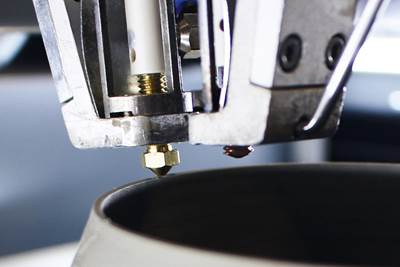CMC nose, control surfaces for Space Rider TPS pass dynamic structural qualification
Largest melt infiltrated ceramic matrix composite part to date and complex body flap assembly achieve key milestone ahead of manufacturing the flight unit for Europe’s first reusable space vehicle.
Source | CIRA
The nose and body flap of the Space Rider, designed by (Capua, Italy) and manufactured in collaboration with (Stezzano, Italy), have successfully passed their dynamic structural qualification campaign, confirming the full integrity of the components ahead of the flight unit's manufacturing.
This achievement marks a key milestone for the Space Rider, to be the first European reusable space transportation system, developed under the with Italy as the prime contractor. (See CW’s article on the Space Rider’s complete TPS).
“The Space Rider nose is one of the most difficult technological challenges we have faced so far," says Giuseppe Rufolo, CIRA program manager. “The success of these tests is the culmination of 4 years of intense work and paves the way for the completion of the Space Rider TPS.”
“The completion of the dynamic qualification of the ceramic-based composite nose is a key milestone for the Space Rider program,” adds Daniele Francesconi, Thales Alenia Space Italia program manager. “This achievement is [thanks to] the successful collaboration between the research center and small- and medium-sized industries in overcoming major technological challenges, which are essential for the atmospheric re-entry of reusable space vehicles.”
According to Aldo Scaccia, ESA Space Rider space segment manager, this qualification represents a major advance for Space Rider. “The nose, a crucial part of the vehicle’s thermal protection system [TPS] for the hypersonic atmospheric re-entry, is essential to the mission’s success.”
The nose is one of the most complex components of the vehicle’s TPS, featuring a structure that integrates around 1,200 elements. At the heart of the system is a 130-centimeter-diameter dome made from ISiComp ceramic matrix composite (CMC) — said to be the largest ever made using liquid silicon infiltration (LSI) technology. ISiComp is a carbon fiber-reinforced carbon/silicon carbide (C/C-SiC) CMC developed jointly by CIRA and Petroceramics. Weighing just 40 kilograms, the nose can withstand temperatures of up to 1650°C, maintain its aerodynamic shape with deformations of less than 1 millimeter and withstand launch loads.
Measuring 900 × 700 millimeters with a mass of just 10 kilograms, the ISiComp body flap assembly (BFA) features a complex geometry capable of ensuring the aerodynamic performance and thermo-structural characteristics necessary to withstand a demanding combination of mechanical and thermal loads, with temperatures reaching up to 1650°C.
The particular configuration of the flap and the interface system, with metallic supports and bearings, creates a strong coupling of the structure with the vibro-acoustic stresses of the Vega-C rocket. This makes laboratory tests critical, as they must be both representative and safe for the integrity of the component.
Efficient, robust testing and qualification
The Space Rider project team at CIRA has developed an advanced methodology to define nominal load profiles, mitigating the amplification of dynamic stresses induced by laboratory tests. Based on load monitoring using accelerometers and FEM analysis, this methodology reduces uncertainties and generates test profiles representative of operational conditions. This approach is said to represent a significant evolution toward efficient and robust dynamic qualification, contributing to ensuring the safety and reliability of the Space Rider during its missions.
The methodology was applied to the dynamic testing campaign on the “Qualification Model” of the body flap, the first component of the Space Rider TPS to be qualified. The dynamic testing campaign, conducted by the CIRA Space Qualification Laboratory, assessed the behavior of the nose and BFA structures under vibrational loads representative of launch conditions. Its success demonstrates the effectiveness of an implementation model that leverages synergies between design expertise and experimental capabilities.
Related Content
Plant tour: Airbus, Illescas, Spain
Airbus’ Illescas facility, featuring highly automated composites processes for the A350 lower wing cover and one-piece Section 19 fuselage barrels, works toward production ramp-ups and next-generation aircraft.
Read MoreThe next-generation single-aisle: Implications for the composites industry
While the world continues to wait for new single-aisle program announcements from Airbus and Boeing, it’s clear composites will play a role in their fabrication. But in what ways, and what capacity?
Read MoreLow-cost, efficient CFRP anisogrid lattice structures
CIRA uses patented parallel winding, dry fiber, silicone tooling and resin infusion to cut labor for lightweight, heavily loaded space applications.
Read More“Structured air” TPS safeguards composite structures
Powered by an 85% air/15% pure polyimide aerogel, Blueshift’s novel material system protects structures during transient thermal events from -200°C to beyond 2400°C for rockets, battery boxes and more.
Read MoreRead Next
CIRA qualifies CMC structures for the reusable Space Rider
Italian team designs, builds and tests multiple large, complex thermal protection system structures made from patented ISiComp C/C-SiC ceramic matrix composites.
Read MoreA new era for ceramic matrix composites
CMC is expanding, with new fiber production in Europe, faster processes and higher temperature materials enabling applications for industry, hypersonics and New Space.
Read MoreScaling up, optimizing the flax fiber composite camper
Greenlander’s Sherpa RV cab, which is largely constructed from flax fiber/bio-epoxy sandwich panels, nears commercial production readiness and next-generation scale-up.
Read More









